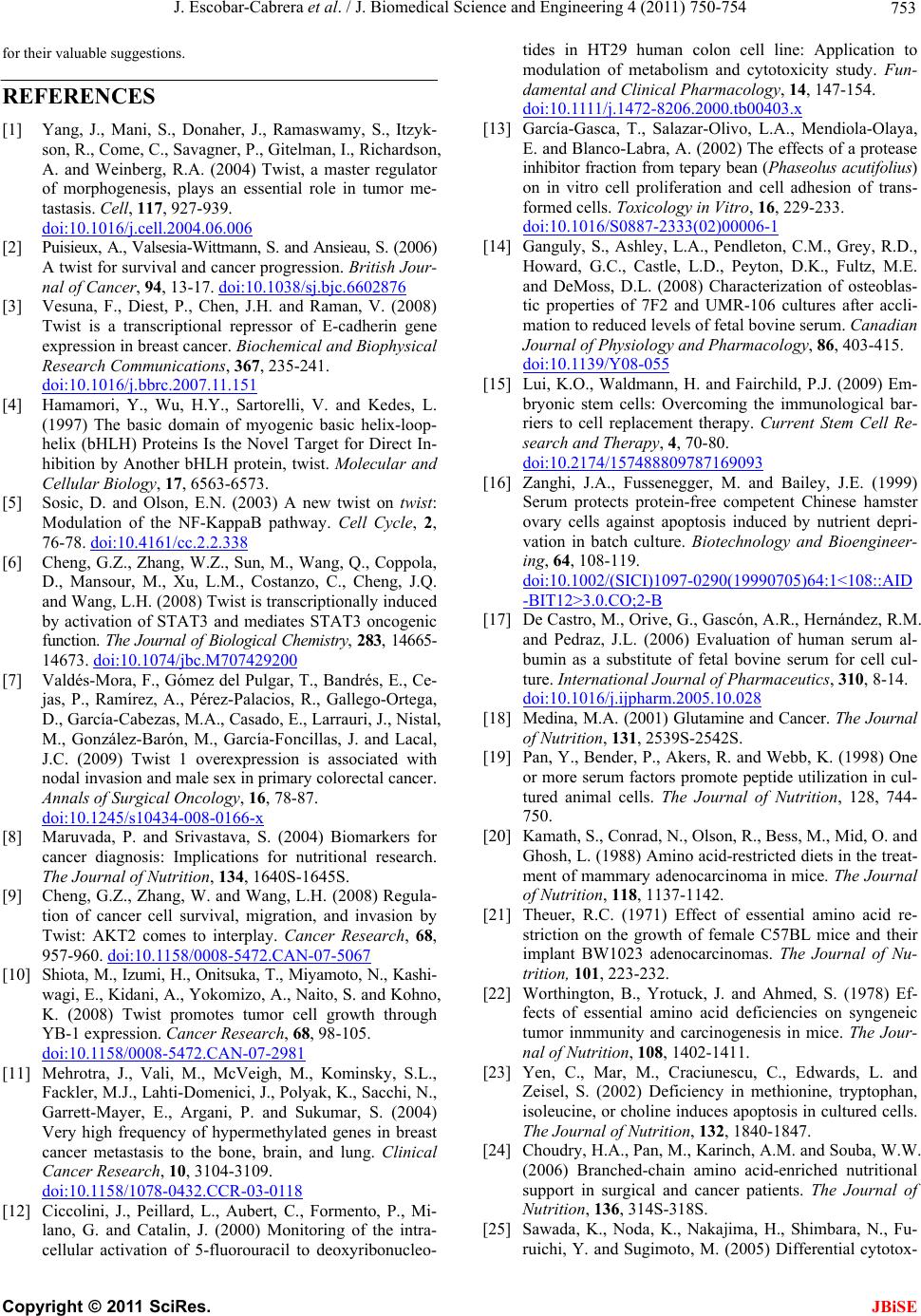
J. Escobar-Cabrera et al. / J. Biomedical Science and Engineering 4 (2011) 750-754 753
for their valuable suggestions.
REFERENCES
[1] Yang, J., Mani, S., Donaher, J., Ramaswamy, S., Itzyk-
son, R., Come, C., Savagner, P., Gitelman, I., Richardson,
A. and Weinberg, R.A. (2004) Twist, a master regulator
of morphogenesis, plays an essential role in tumor me-
tastasis. Cell, 117, 927-939.
doi:10.1016/j.cell.2004.06.006
[2] Puisieux, A., Valsesia-Wittmann, S. and Ansieau, S. (2006)
A twist for survival and cancer progression. British Jour-
nal of Cancer, 94, 13-17. doi:10.1038/sj.bjc.6602876
[3] Vesuna, F., Diest, P., Chen, J.H. and Raman, V. (2008)
Twist is a transcriptional repressor of E-cadherin gene
expression in breast cancer. Biochemical and Biophysical
Research Communications, 367, 235-241.
doi:10.1016/j.bbrc.2007.11.151
[4] Hamamori, Y., Wu, H.Y., Sartorelli, V. and Kedes, L.
(1997) The basic domain of myogenic basic helix-loop-
helix (bHLH) Proteins Is the Novel Target for Direct In-
hibition by Another bHLH protein, twist. Molecular and
Cellular Biology, 17, 6563-6573.
[5] Sosic, D. and Olson, E.N. (2003) A new twist on twist:
Modulation of the NF-KappaB pathway. Cell Cycle, 2,
76-78. doi:10.4161/cc.2.2.338
[6] Cheng, G.Z., Zhang, W.Z., Sun, M., Wang, Q., Coppola,
D., Mansour, M., Xu, L.M., Costanzo, C., Cheng, J.Q.
and Wang, L.H. (2008) Twist is transcriptionally induced
by activation of STAT3 and mediates STAT3 oncogenic
function. The Journal of Biological Chemistry, 283, 14665-
14673. doi:10.1074/jbc.M707429200
[7] Valdés-Mora, F., Gómez del Pulgar, T., Bandrés, E., Ce-
jas, P., Ramírez, A., Pérez-Palacios, R., Gallego-Ortega,
D., García-Cabezas, M.A., Casado, E., Larrauri, J., Nistal,
M., González-Barón, M., García-Foncillas, J. and Lacal,
J.C. (2009) Twist 1 overexpression is associated with
nodal invasion and male sex in primary colorectal cancer.
Annals of Surgical Oncology, 16, 78-87.
doi:10.1245/s10434-008-0166-x
[8] Maruvada, P. and Srivastava, S. (2004) Biomarkers for
cancer diagnosis: Implications for nutritional research.
The Journal of Nutrition, 134, 1640S-1645S.
[9] Cheng, G.Z., Zhang, W. and Wang, L.H. (2008) Regula-
tion of cancer cell survival, migration, and invasion by
Twist: AKT2 comes to interplay. Cancer Research, 68,
957-960. doi:10.1158/0008-5472.CAN-07-5067
[10] Shiota, M., Izumi, H., Onitsuka, T., Miyamoto, N., Kashi-
wagi, E., Kidani, A., Yokomizo, A., Naito, S. and Kohno,
K. (2008) Twist promotes tumor cell growth through
YB-1 expression. Cancer Research, 68, 98-105.
doi:10.1158/0008-5472.CAN-07-2981
[11] Mehrotra, J., Vali, M., McVeigh, M., Kominsky, S.L.,
Fackler, M.J., Lahti-Domenici, J., Polyak, K., Sacchi, N.,
Garrett-Mayer, E., Argani, P. and Sukumar, S. (2004)
Very high frequency of hypermethylated genes in breast
cancer metastasis to the bone, brain, and lung. Clinical
Cancer Research, 10, 3104-3109.
doi:10.1158/1078-0432.CCR-03-0118
[12] Ciccolini, J., Peillard, L., Aubert, C., Formento, P., Mi-
lano, G. and Catalin, J. (2000) Monitoring of the intra-
cellular activation of 5-fluorouracil to deoxyribonucleo-
tides in HT29 human colon cell line: Application to
modulation of metabolism and cytotoxicity study. Fun-
damental and Clinical Pharmacology, 14, 147-154.
doi:10.1111/j.1472-8206.2000.tb00403.x
[13] García-Gasca, T., Salazar-Olivo, L.A., Mendiola-Olaya,
E. and Blanco-Labra, A. (2002) The effects of a protease
inhibitor fraction from tepa ry bean (Phaseolus acutifolius)
on in vitro cell proliferation and cell adhesion of trans-
formed cells. Toxicology in Vitro, 16, 229-233.
doi:10.1016/S0887-2333(02)00006-1
[14] Ganguly, S., Ashley, L.A., Pendleton, C.M., Grey, R.D.,
Howard, G.C., Castle, L.D., Peyton, D.K., Fultz, M.E.
and DeMoss, D.L. (2008) Characterization of osteoblas-
tic properties of 7F2 and UMR-106 cultures after accli-
mation to reduced levels of fetal bovine serum. Canadian
Journal of Physiology and Pharmacology, 86, 403-415.
doi:10.1139/Y08-055
[15] Lui, K.O., Waldmann, H. and Fairchild, P.J. (2009) Em-
bryonic stem cells: Overcoming the immunological bar-
riers to cell replacement therapy. Current Stem Cell Re-
search and Therapy, 4, 70-80.
doi:10.2174/157488809787169093
[16] Zanghi, J.A., Fussenegger, M. and Bailey, J.E. (1999)
Serum protects protein-free competent Chinese hamster
ovary cells against apoptosis induced by nutrient depri-
vation in batch culture. Biotechnology and Bioengineer-
ing, 64, 108-119.
doi:10.1002/(SICI)1097-0290(19990705)64:1<108::AID
-BIT12>3.0.CO;2-B
[17] De Castro, M., Orive, G., Gascón, A.R., Hernández, R.M.
and Pedraz, J.L. (2006) Evaluation of human serum al-
bumin as a substitute of fetal bovine serum for cell cul-
ture. International Journal of Pharmaceutics, 310, 8-14.
doi:10.1016/j.ijpharm.2005.10.028
[18] Medina, M.A. (2001) Glutamine and Cancer. The Journal
of Nutrition, 131, 2539S-2542S.
[19] Pan, Y., Bender, P., Akers, R. and Webb, K. (1998) One
or more serum factors promote peptide utilization in cul-
tured animal cells. The Journal of Nutrition, 128, 744-
750.
[20] Kamath, S., Conra d, N. , Olson, R. , Be ss, M., Mi d, O. an d
Ghosh, L. (1988) Amino acid-restricted diets in the treat-
ment of mammary adenocarci noma in mice. The Journal
of Nutrition, 118, 1137-1142.
[21] Theuer, R.C. (1971) Effect of essential amino acid re-
striction on the growth of female C57BL mice and their
implant BW1023 adenocarcinomas. The Journal of Nu-
trition, 101, 223-232.
[22] Worthington, B., Yrotuck, J. and Ahmed, S. (1978) Ef-
fects of essential amino acid deficiencies on syngeneic
tumor inmmunity and carcinogenesis in mice. The Jour-
nal of Nutrition, 108, 1402-1411.
[23] Yen, C., Mar, M., Craciunescu, C., Edwards, L. and
Zeisel, S. (2002) Deficiency in methionine, tryptophan,
isoleucine, or choline induces apoptosis in cultured cells.
The Journal of Nutrition, 132, 1840-1847.
[24] Choudry, H.A., Pan, M., Karinch, A.M. and Souba, W.W.
(2006) Branched-chain amino acid-enriched nutritional
support in surgical and cancer patients. The Journal of
Nutrition, 136, 314S-318S.
[25] Sawada, K., Noda, K., Nakajima, H., Shimbara, N., Fu-
ruichi, Y. and Sugimoto, M. (2005) Differential cytotox-
C
opyright © 2011 SciRes. JBiSE